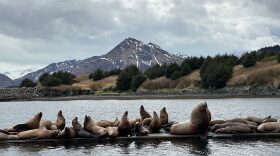Editor’s Note: Some photos depict the sea lion's wounds, blood, and the packing band being removed. Viewer discretion is advised.
Sea lions are a common sight in Kodiak – there’s even a floating dock for them in the St. Herman Harbor on Near Island.
The Sun’aq Tribe received reports of one caught in a plastic packing band as early as January, but staff weren’t able to work on it until May. Matt Van Daele, the Tribe’s natural resources director, said the patient was a male between 8 and 10 years old.
“Every single time that poor guy moved at all, it would just cut, it would just reopen wounds,” he said. “I can’t even imagine how uncomfortable it must have been for him.”
Steller sea lions west of the panhandle are an endangered species and can be hurt from getting caught in marine debris.

It’s the second year in a row the Sun’aq Tribe disentangled a sea lion this time of year. The Tribe helped a yearling female during CrabFest last year too. Van Daele said the festival happens between when sea lions feed on herring but before their breeding season.
“We’ve got these little windows of opportunity that are ideal for trying to capture and disentangle these animals with injuries – and it seems like it happens right around CrabFest,” he said.
Both sea lions lived, but there’s a lot that could have gone wrong.
Tranquilizing darts can fail, animals can attempt to swim away before they’re fully asleep, or even disappear between when a report is made and help arrives. The most recent animal was observed regularly in the harbor though, which gave Sun’aq Tribe staff time to call in experts.
Lauri Jemison, a wildlife biologist with the Alaska Department of Fish and Game said the disentanglement went well.
“We always do a debrief at the end of a disentanglement whether it’s successful or not because there are a lot of lessons – we always learn because every situation is unique,” she said.
Jemison said she was grateful for community support, from the reports to people volunteering their boats and helping on the docks.
Van Daele said it was a stark reminder how poorly disposed garbage affects animals.

“That still just blows my mind that a packing band did that to that animal – and it most likely would have died had we not intervened," Van Daele said. "But that being said, we can also have an outsized influence on just cutting those things before we dispose of them."
Entangled marine mammals can be reported to the National Oceanic and Atmospheric Administration’s 24-hour hotline at (877) 925-7773. Experts stress that the public should not disentangle animals themselves and wait for professionals to arrive.
Van Daele said he hopes to increase information efforts to encourage more people to cut plastic bands before throwing them away to reduce the number of entangled animals.




